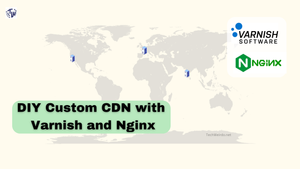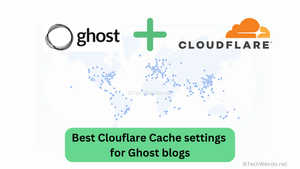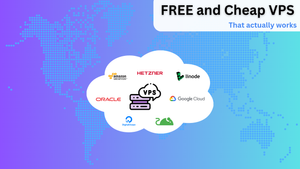Hi, welcome to The TechWeirdo. In this post I am going to list different free tier cloud offerings that actually work for free and can be used in daily basis or in production. Searching for this topic on Google is frustrating and waste a lots of time. So here is my curated list of free tier services and providers that I have used over the past 2 years and using currently. Hope you find it helpful too.
Free tier VM
VPS is Virtual Private Server, i.e. a computer or a part of a computer you can rent from other companies to run anything you want. The there are many companies from large to small offering VPS, but only 2 of them (technically 3) offers a free tier service, Oracle Cloud and Google Cloud. Getting a free account from Google is easy, you already have one, creating one with Oracle was a bit trickier, but my recent experience for the last 1 year is very pleasant with both of them.
1. Oracle Cloud Free Tier
Oracle's free tier is unmatched and too good to be true. Here is their offerings:
- A total of 4 cores and 24 GBs of RAM worth of Ampere A1 computer (Arm 64 chip).
- Two 1 core (2 vcpus per core) and 1 GB of RAM AMD (amd64/x86) hardware.
- A total of 200GB of fast NVMe SSD storage.
- 10 TB of Bandwidth.
Oracle removes running VMs on free accounts if usage is low (which is almost always). To avoid this upgrade your account to PYAG. You won't get charged unless you exceed the free tier limit.
2. Google Cloud Free Tier
Google also has generous free tier, and recently increased their free limits. Although their free tier resource pale in comparison to Oracle's, they are actually fairly capable to run decent workload like a small website or a small VPN or monitoring server. Here is what Google offers.
- 1e2micro: One 1 core CPU ( 2vcpu) 1 GB RAM (x86/ame64) hardware usually old generation Intel. Remember only locations where you will get this e2micro for free are us-east-1 (South Carolina) us-west-1 (Oregon) and us-central-1 (Iowa).
- 30 GB of standard HDD storage
- 200 GB of standard tier egress bandwidth. (Standard tier), 1 GB in premium tier.
Give special focus on selecting standard persistent storage, and standard tier network.
3. Fly.Io free tier
Fly is a different type of cloud provider, they don't directly sell bare bone VPS, Instead you can run any app using docker container. You have to deploy them using command line, no UI available.
- Upto 3 shared-cpu-1x 256mb VMs.
- 3 GB persistent volume storage.
- 160 GB bandwidth
- They don't send you a bill if it is below 5 dollars
That's all for free VPS. AWS also has a free VPS (1 core 1GB ram, 30 GB SSD and 100 GB bandwidth) but that is free for 1 year only, so I haven't included it in this free tier list. That's all the free tier VPS.
Some honourable mentions (very cheap alternative to free tier) includes DigitalOcean, Linode and Pikapods.
For free tier vps you should read the dedicated article to know about them in details.
Free Tier CDN
CDN or Content Delivery Network are responsible in making your internet property faster, by replicating contents of your website at multiple locations accross the globe and serving them from nearest location from your user. It gives you massive speed benefit, massive scalability and cost cutting. And some popular CDNs are Cloudflare, Cloudfront etc. And in this category Cloudflare blows everyone out.

1. CloudFlare CDN
Cloudflare is one of the most loved company among all cloud providers, specially for their impressive free tiers. And they continuously innovates and increases their free tier too. Currently it has become a routine for everyone to just add their domain to cloudflare after they purchase a domain name. They handel over 20% of internet traffic. Here is their free tier offerings.
- Unlimited (Truly unlimited) bandwidth.
- 310+ location all available to free tier.
- Free DDOS protection.
- Free Web Application Firewall for protecting you website.
- 10 GB of object storage (like s3 bucket) but with free egress.
- Cloudflare acts as a reverse proxy, so it also hides your VPS IP address front the internet
And there is many more improvements they provide you for free. I will write some in the server less segment, but Cloudflare free tier actually deserve 1-2 dedicated blog posts of there own. So yes CDN = Cloudflare.
If you site has very low traffic don't expect Cloudflare to be the fastest one though. The purge cache aggressively from their edges because they have so many free sites and resource is expensive.

2. Cloudfront
For some reason if you don't want to use CloudFlare, or if you plan to do so large file delivery like videos etc then AWS CloudFront can be a good option, they have a good free tier
- 450+ point of presence.
- 1 TB per month worth of free bandwidth.
But they charge for WAF and DDOS bill. And after 1TB they get expensive fast costing and average of 100 USD per 1 TB after the first one.
That is all the free tier generalized CDNs I am going to recommend to you. Although I also like Bunny CDN for their extremely low cost and fantastic support. Bunny is almost 10-50 times cheaper to Cloudfront. And they consistently tops CDNperfs chart for being the fastest CDN.
3. Image and Video CDN
Cloudflare and Cloudfronts are generalized CDNs you upload a file and they delivers. But there are some special CDNs that are specially designed to deliver images and videos. Some popular options are Gumlet, Cloudinay, Imagekit, Optimole. This CDNs are built on top of traditional CDNs, like Gumlet uses Fastly, Optimole uses cloudfront. What they do extra is they take your photos and videos, then compress and optimise it for different qualities and sizes for different devices and then deliver the best size for each visitor, saving a tons of bandwidth and making a webpage load much faster. Some good options are:
- Gumlet Image and Video CDN: Gumlet offers 30 GB of free image bandwidth and 250 GBs of video bandwidth. But they don't have image storage, so you need an external image storage(like r2/s3). I will write a post about how I built my complete image delivery solution later.
- Optimole: If you have a small wordpress website then Optimole is a great option. They offers free 5000visitors per month for free.
In my experience these CDNs will be able to meet all your CDN related needs at the best price possible (Starting with free), without compromising any quality of service.
VPS and CDNs are only a part of web now. Now there are many other fancy stuffs powering the web like serverless computing (basically serversof others, but you don't need to have a dedicated one), managed database, static site hostings, Deploying mordern frameworks like nextjs etc. I am grouping them all under other free tier services below.
Other free tier services
1. Static site hosting
You website is basically a bunch of html css and javascript files. So you can bundel them up upload them and voila they are available globally, that is the plan here. You can deploy any basic html site, a blog, that you built using static site generators like Hugo, Astro, etc. Oh btw, this things deploy globally accross all their edge networks, so basically deploying you app directly on a CDN. The providers are:
- Cloudflare Pages: Unlimited bandwidth, 500 websites.
- GitHub pages: 1 website and 100 GB bandwidth.
- Vercel: 200 sites, 100 GB.
- Netlify: 500 sites 100 GB
- Kinsta: Same as above
2. Serverless Edge Functions
Serverless functions are code that runs at the edge. You don't have a monolithic server at any particular location. When a request is made, it travels to the nearest edge, the program runs, work completes everything goes to silent. So you pay for exactly what you use and it can scale to billions of requests from zero and goes back to zero within seconds. But depending on the service and capability, the performance and functionality varies. Some free tier providers in this domains are:
- Cloudflare Workers: They have no cold start latency, can run javascript and now python too at the 300+ edge locations and also ai models. 100,000 requests per day is free paid plan includes 10 million request for 5 dollars and then 1 million for 30 cents. I actively use workers very much, and I am running different projects on workers too like link shortener I use daily, todolists etc, and expect a lots of future posts about cloudflare workers here.
- AWS lambda and lambda at edge: Lambda at edge is more like workers, that deploys at cloudfront edge networks and integrates with their CDN, and lambda is deployed at specific locations. AWS offers 1 million request per month for free for lamba but lambda comes with cold start delays.
There are many other providers like Google edge runtime, Vercel edge functions, and they all offers free tiers.
My expertise in Serverless functions, Backend as a service and managed database is limited. I heavily use cloudflare workers now. I have some simple projects running on vercel too. I have tried firebase, Supabase, MongoDB and lambda, but I have not used them in any projects or in long term.
3. Backend as a service
Backend as a service are providers that gives you everything you need at the backend of you app, i.e. a database, user authentication, api, edge functions, storage, subscription etc. Two of the most popular providers Firebase and Supabase both offers generous free tiers. Firebase is closed source by Google and runs on GCP and have more featurs. Supabase is opensource and they provide paid managed solution with good free tier and overall is cheaper than firebase. You should choose which ever meets your goal better.
4. Database as a service
Database is complex and managing one is not very exciting, so is the free tier space for managed database. And following the latest planetscale incident, I can't recommend you any free tier for managed database. You can try Supabase,Vercel etc.
5. Object storage
Object storage services are a very useful thing to store and distribution your site data, like different files formats. I use then to store images, videos to deliver on websites. Some most notable providers with generous free tiers are:
- Cloudflare R2:
- s3 compatible
- Free unlimited egress
- Generate free class A and class B operations.
- First 10GB of free storage (0.015/GB after that), they have also added Infrequent access mode.
- Backblaze B2 🔗
- s3 compatible
- Free egress for upto 3 times the storage used. (i.e. 45 GB free if you store 15 GB data)
- First 10 GB free then 0.006/GB
- Higher class A and class B operation cost than cloudflare
- Amazon S3:
- s3 was a king once now the above 2 is taking over so, others have to advertise s3 compatibility.
- 5 GB storage free then 0.023/GB for frequent access tier ( Infrequent access cost less, but has large retrieval cost).
- Their is cost for each operations (Class A and class B)
- First 100 GB free bandwidth then 0.09usd/GB. 1 TB free bandwidth when delivered via cloudfront CDN.
For high demanding application you should calculate the bill as per the pricing of all the 3 providers and the go with the one that makes most sense. For example I use r2 for website traffic as I don't exceed 10 GB free tier. But for jellyfin in Cloud I used Backblaze because the have cheaper storage.
Conclusion
Well, let's wrap it up, it has gone far too long. I hope you are awake and have reached upto this point safely. There are so many services and so it got this big. The point is don't pay enormous bill to any particular cloud provider. Look at your problem, then find the most efficient way to solve it (take you time's value as a cost too), then find the most economical place to deploy your solution.
I spent lot of time testing these stuffs, so that you don't have to waste your time falling for those deceptive scam paid headlines in Google search, if you find this article. If I have helped to you save your time, then please comment down below and signup for the free newsletter, I hope we will build a long lasting friendships. Thank you for reading The TechWeirdo.






